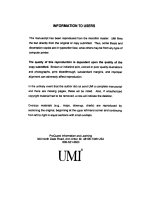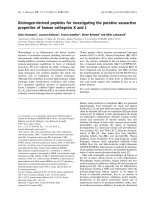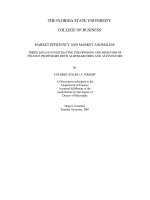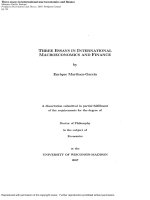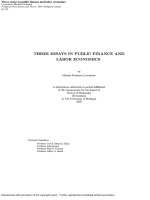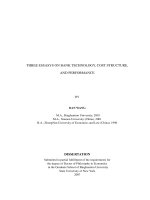market efficiency and market anomalies three essays investigating the opinions and behavior of finance professors both as researchers and as investors
Bạn đang xem bản rút gọn của tài liệu. Xem và tải ngay bản đầy đủ của tài liệu tại đây (2.48 MB, 155 trang )
THE FLORIDA STATE UNIVERSITY
COLLEGE OF BUSINESS
MARKET EFFICIENCY AND MARKET ANOMALIES:
THREE ESSAYS INVESTIGATING THE OPINIONS AND BEHAVIOR OF
FINANCE PROFESSORS BOTH AS RESEARCHERS AND AS INVESTORS
By
COLBRIN (COLBY) A. WRIGHT
A Dissertation submitted to the
Department of Finance
in partial fulfillment of the
requirements for the degree of
Doctor of Philosophy
Degree Awarded:
Summer Semester, 2007
UMI Number: 3282678
3282678
2007
Copyright 2007 by
Wright, Colbrin A.
UMI Microform
Copyright
All rights reserved. This microform edition is protected against
unauthorized copying under Title 17, United States Code.
ProQuest Information and Learning Company
300 North Zeeb Road
P.O. Box 1346
Ann Arbor, MI 48106-1346
All rights reserved.
by ProQuest Information and Learning Company.
The members of the Committee approve the dissertation of Colbrin A. Wright defended
on May 22, 2007.
_____________________________
David Peterson
Professor Directing Dissertation
_____________________________
Michael Brady
Outside Committee Member
_____________________________
Gary Benesh
Committee Member
_____________________________
James Doran
Committee Member
Approved:
_________________________________
William Christiansen, Chair, Department of Finance
_________________________________
Caryn L. Beck-Dudley, Dean, College of Business
The Office of Graduate Studies has verified and approved the above named committee
members.
ii
To my wonderful wife, Misty, whose unremunerated and oft-times unrecognized
work as a mother is both unequivocally more challenging and infinitely more important
than any of my professional accomplishments. Thanks for being my rock when the
winds and rains have beat upon me.
iii
ACKNOWLEDGEMENTS
No great work in life is ever accomplished alone. While readily acknowledging
that my dissertation is no “great work,” I would like to gratefully acknowledge the many
individuals who have improved the quality of this dissertation and influenced me along
the way. First, thanks to my dissertation chair, Dr. David Peterson, who was mercilessly
forced to read literally hundreds of pages of my writing. His questions, candor, direction,
and suggestions have been invaluable. He, more than anyone else, has taught me how to
be a researcher. Also, I sincerely thank each of the other members of my dissertation
committee. Dr. Gary Benesh provided the voice of reason and experience. His candid
feedback on the survey instrument and on the volume of work I initially proposed proved
invaluable and prophetic. Dr. Mike Brady has been my brightly burning torch in an
otherwise dark room as I constructed, distributed, and analyzed the responses to the
survey. Dr. James Doran became my reason to keep working. On the days of frustration
and disappointment, which accompany all dissertations, he was the optimistic cheerleader
and demanding coach pushing me to keep going. His suggestions tremendously
improved the quality of the work. I also want to thank Dr. Bill Christiansen whose
instruction, mentoring, advice, and friendship have meant more to me than he will ever
know.
In addition to those mentioned above, I wish to thank the following individuals
for their insightful suggestions, questions, and interest in my work: Prithviraj Banerjee,
Jim Brau, Ronnie Clayton, Dean Diavatopolous, Michael Ehrhardt, Campbell Harvey,
Matthew Spiegel, Tom Noe, Jeff Rockwell, Brian Tarrant, seminar participants at Central
Michigan University, all respondents to my survey (especially those who provided
feedback), and the entire finance faculty at Florida State University. Dave Horowitz, Tim
Munyon, and Andrew Wilson provided much appreciated guidance in executing the
structural equation modeling testing in the dissertation. Also, surveyZ and Qualtrics.com
saved me countless hours of work by generously allowing me to use their survey software
free of charge. Jean Heck graciously gave me access to his database that also greatly
expedited the completion of the dissertation. Lastly, I thank Misty Wright for her expert
assistance in collecting the data for this study. All errors in this dissertation are mine.
iv
TABLE OF CONTENTS
LIST OF TABLES vi
LIST OF FIGURES vii
ABSTRACT viii
INTRODUCTION AND MOTIVATION 1
How Efficient Do We Think Us Stock Markets Are And Does It Really Matter? 3
What Really Matters When Buying and Selling Stock? 5
So You Discovered an Anomaly…Gonna Publish It? 6
Outline of Dissertation 9
HOW EFFICIENT DO WE THINK US STOCK MARKETS ARE AND DOES IT
REALLY MATTER? 10
Introduction 10
Background 11
Subjects, Surveys, and Response Rate 13
How Efficient are US Markets? 19
Assessing Views of Market Efficiency Based on Investing Objectives 23
Does Market Efficiency Even Matter? 24
Conclusion 35
WHAT REALLY MATTERS WHEN BUYING AND SELLING STOCKS? 46
Introduction 46
Background 47
Surveys in Finance Literature 52
Survey Subjects, Description, and Distribution 53
Results 56
Conclusion 67
SO YOU DISCOVERED AN ANOMALY…GONNA PUBLISH IT? 84
Introduction 84
The Theory and Assumptions 86
Model Implications 92
Analysis of Empirical Implications – Data and Methods 94
Analysis of Empirical Implications – Results 101
Conclusion and Discussion 110
CONCLUSION 125
APPENDIX 127
REFERENCES 138
BIOGRAPHICAL SKETCH 144
v
LIST OF TABLES
1. Summary Statistics 37
2. Opinions About Market Efficiency by Rank 38
3. Market Efficiency Specialists’ Opinions About Market Efficiency 39
4. Respondents’ Propensities to Actively Invest by Rank 40
5. Respondents’ Propensities to Actively Invest by Specialty 41
6. The Congruence of Respondents’ Opinions and Investment Objectives 42
7. Respondents’ Investment Objectives as a Function of Their Opinions and Confidence 43
8. Explaining Investment Objectives – Ordered Probit Analysis 44
9. Summary Statistics Reproduced 69
10. Relative Importance of 14 Groups of Variables 70
11. Relative Importance of 43 Individual Variables 71
12. Investment Experience by Rank 74
13. Respondents Who Have No Experience 75
14. Investment Experience by Gender 76
15. Ordered Probit Analysis of Investment Experience 77
16. What Matters to Active Investors 78
17. What Groups of Variables Matter to Active Investors 80
18. What Matters to Active Traders 81
19. Anomalies and Authors 112
20. Differences in Means and Medians: Anomaly vs. Matched Authors 113
21. Singe-Variable Probit Analyses 115
22. Full Specification Probit Analyses 116
23. Multicollinearity Mitigated Probit Analyses 119
24. Preliminary Regression Analyses 120
25. Multicollinearity Mitigated Regression Analyses 121
26. Principal Components 123
27. Principal Components Regression Analyses 124
vi
LIST OF FIGURES
I.
Structural Equation Modeling Path Diagram
45
II.
Holdings of Active Investors
82
vii
ABSTRACT
I study the topics of market efficiency and anomalies to market efficiency by
focusing on finance professors in their joint roles as both researchers and market
participants. I ask three main research questions: (1) how efficient do finance professors
believe US stock markets are and does their opinion of market efficiency influence their
investing behavior, (2) what really matters to finance professors when they buy and sell
stocks, and (3) why do finance professors publish market anomalies?
Related to the first question, I discover that finance professors agree that US stock
markets are weak form efficient but not strong form efficient. However, there is much
disagreement about the semi-strong form efficiency of US stock markets. Their investing
behavior, though, suggests that finance professors accept markets as semi-strong form
efficient; twice as many finance professors passively invest than actively invest.
Surprisingly, their opinion about market efficiency has very little to do with their
investing behavior. Instead, their investing behavior seems primarily driven by their
confidence in their own abilities to beat the market, regardless of how efficient they
perceive US stock markets to be.
Related to the second question, I present three main findings. First, traditional
valuation techniques and asset-pricing models commonly used in research and taught in
the classroom are universally unimportant to finance professors when they buy and sell
stocks. Second, the most important information to finance professors when considering
stock purchases and sales are firm characteristics (PE ratio and market capitalization) and
momentum related information (the stock’s return over the past six to 12 months and 52-
week high and low). Third, finance professors have less real-world investing experience
than one might expect – the median professor has bought an individual stock between 10
and 19 times, and 14.5% have never done so.
Related to the third question, I find that finance professors are, in fact, acting
rationally when they publish market anomalies. The theory I develop suggests it is
rational for researchers to publish market anomalies if they have relatively few previous
publications or have lesser reputations. Accordingly, the theory implies that the
likelihood of publishing an anomaly and the profitability of published anomalies should
be inversely related to the authors’ previous publications and reputation. These
viii
implications are empirically corroborated providing evidence for the theory and
supporting the notion that researchers are behaving rationally when they publish. Sadly,
this also suggests that it is very likely that profitable anomalies have been discovered but
not published so that the discoverer can exploit the anomaly, which provides indirect
evidence of market inefficiency.
ix
CHAPTER 1
INTRODUCTION AND MOTIVATION
Finance professors are compensated to read and perform high-level research on
the subject of investing. Further, they teach the subject to undergraduate and graduate
students. In addition to teaching and researching the topic, they also participate as
individual investors directing the allocation of their own personal portfolios. Some of
them are also privileged to participate at an even higher level by acting as professional
managers.
Hence, finance professors occupy a unique and privileged position. They are both
researchers and participants in the arena of investing. They are abundantly educated,
well informed, and highly sophisticated individuals who have the opportunity to apply
the knowledge and sophistication gained through their research and teaching activities by
participating in the very market they study. Additionally, the research they perform
actually influences the arena in which they participate.
Finance professors, then, represent a strikingly unique group. Yet to date they
have almost been entirely ignored in their unique joint role as both researchers and
participants. I can locate only one article that acknowledges and studies the dual role of
finance professors – Haddad and Redman (2005). They survey finance, accounting, and
economics professors to study four areas related to academics as investors: (1) current
asset allocation, (2) expected sources of retirement income, (3) expected retirement asset
allocation, and (4) types of financial instruments used.
Considering the fact that only one article has explicitly recognized the important
dual role of finance professors and that this article had a relatively limited scope, I see
ample opportunity for productive and useful research in this area. Similar to Haddad and
Redman (2005), I begin by recognizing the unique positions of finance professors as
researchers and participants in the arena of investing. The topic of my work, however,
substantially diverges from theirs. My dissertation is a compilation of three essays
studying the subject of market efficiency and market anomalies through an in depth
1
analysis of finance professors in their joint role both as researchers and as market
participants.
The first two essays are based on a survey distributed to all finance professors at
accredited, four-year universities and colleges in the United States. In the first essay, I
concentrate on the issue of market efficiency. I ask finance professors five questions to
assess how efficient they believe US stock markets truly are. I also empirically test, and
ultimately refute, the notion that an investor’s decision to actively or passively invest is
based on his perception of the efficiency of the market in which he is considering
investing. In the second essay, I ask finance professors to identify which asset-valuation
techniques, asset-pricing models, market anomalies, and other information are most and
least important when they invest. In the second essay, I also analyze how much real-
world investing experience finance professors possess.
I am not the first to survey finance professors to assess their opinions on these
matters. Welch (2000) surveys financial economists to develop a consensus estimate of
the equity premium over a set of future horizons. As a secondary (arguably tertiary)
matter, he also asks them a set of questions about “issues that are commonly debated in
the academic literature.” Included in his survey are two broad questions about market
efficiency and the stationarity of certain firm characteristics. His cursory treatment of the
topics of this dissertation underscore their importance and also motivate the need for an
in-depth study such as the one I offer.
In the third essay, I address a perplexing question: why do finance professors
publish highly profitable market anomalies? Considerable evidence exists that the
profitability of market anomalies substantially decreases and oft-times entirely disappears
once the anomaly is published (see Dimson and Marsh (1999) and Marquering, Nisser,
and Valla (2006)). Given their role as market participants, finance professors could
easily choose not to publish highly profitable anomalies and instead use them in their
own trading. It doesn’t seem economically rational for a finance professor to publish a
market anomaly, and yet our literature is replete with articles introducing and analyzing
market anomalies (see Russell and Torbey (2002)). In the third essay, I present and
empirically test a theory that explains this ostensibly irrational behavior. I further
motivate each of the three essays below.
2
How Efficient Do We Think Us Stock Markets Are And Does It Really Matter?
Market efficiency has been given tremendous attention in academic literature.
One reason for this is that the actually efficiency of securities markets presumably greatly
influences the strategies investors adopt. Burton G. Malkiel in his book A Random Walk
Down Wall Street explained the matter very eloquently. He remarked that if securities
markets are efficient, “a blindfolded monkey throwing darts at a newspaper’s financial
pages could select a portfolio that would do just as well as one carefully selected by
experts.”
Clearly, understanding the efficiency of securities markets is valuable
information. Unfortunately, the literature on the subject has not definitively identified
how efficient securities markets really are.
There is much empirical evidence demonstrating efficiency in our stock markets.
This is demonstrated by the myriad event studies that report the impounding of
information into prices in an impressively short time period. On top of the academic
evidence, the well-known Wall Street Journal Dartboard Contest seemed to convincingly
validated Malkiel’s statement (see Adams and Cyree (2004) for summary results).
In direct opposition to the efficient-market hypothesis, there is a large body of literature
documenting short-term and long-term return anomalies (see Schwert (2002) and Russell
and Torbey (2002) for insightful surveys of the subject). Market anomalies suggest that
markets are not purely efficient and that investors may be able to construct strategies that
consistently earn abnormal returns.
There is obviously room for debate on the subject of the efficiency of US stock
markets. But in spite of the many published anomalies, the ability of most investors to
earn consistent abnormal returns with real-world investment dollars seems dubious. Even
professional money managers and other sophisticated and informed investors struggle to
beat the market (see Adams and Cyree (2004), Gruber (1996), Carhart (1997), Roll
(1994), and Wermers (2000)).
In the face of mounting evidence that sophisticated investors struggle to beat the
market, investors increasingly appear to be merely passively investing. Battacharya and
3
Galpin (2005) present evidence that stock picking is declining around the globe and
particularly in America, suggesting that investors in general are accepting the argument
that it is extremely difficult to beat the market on a consistent basis. Instead of
attempting to do so, more and more investors are simply passively investing their money
in an attempt to mirror market returns.
Battacharya and Galpin (2005) also note, however, that as more and more
investors passively invest, the Grossman-Stiglitz (1980) paradox suggests markets might
become more inefficient. I.e., the more investors accept and act as if markets are
efficient, the more inefficient they may become, creating opportunities for above-market
returns without having to incur commensurate risk levels.
So it could be that as more and more people accept markets as efficient, the
markets drift toward less efficiency. My objective in the first essay is to determine the
collective opinion of the researchers on the subject through the use of a comprehensive
survey instrument. Further, I aim to discover whether an investor’s perception of market
efficiency really is a fundamental determinant of his investment objectives as many of us
presume it is?
I offer a brief preview of the results. I find that finance professors generally
strongly agree that US stock markets are weak form efficient but that they are not strong
form efficient. There is much disagreement, however, about the semi-strong form
efficiency of US stock markets. The investing behavior of respondents helps to clear up
the disagreement, though. Roughly twice as many respondents passively invest than
actively invest, which suggests finance professors generally accept markets as semi-
strong form efficient. Surprisingly, however, I discover that a finance professor’s
opinion regarding the efficiency of US stock markets has little to do with his investment
behavior and objectives. Using robust methodologies, including ordered Probit analysis
and structural equation modeling, I discover that a respondent’s confidence in his own
abilities to beat the market drive his behavior, not his opinion about the efficiency of the
markets in which he invests, which motivates the need for further work investigating the
role of overconfidence in investing such as that by Barber and Odean (2001).
4
What Really Matters When Buying and Selling Stock?
Similar to market efficiency, the question of what really matters when buying and
selling stock has been the subject of many articles in finance literature. In fact, any
article that deals with market efficiency or market anomalies necessarily addresses this
question. However, once again, there seems to be little consensus about what truly
matters when buying and selling stock.
There exists a broad array of valuation techniques, asset-pricing models, and
anomalies to market efficiency , which all suggest that some unique variable or factor
that is highly relevant when buying or selling stocks. But the collection of literature and
lack of consensus on the matter can be dizzying. Is β really the only thing that matters, as
CAPM suggests? Or perhaps a stock’s correlations with the Fama and French (1993)
factors are also extremely important. What about Carhart’s (1995) momentum factor?
Could a stock’s dividend-yield also be important (Fama and French (1998) and Shiller
(1998))? Or should an investor also look at a stock’s market capitalization (Banz
(1981)), PE ratio (Basu (1977)), book-to-market equity (Stattman (1980)), or 52-week
high and low (George and Hwang (2004))? What about it’s return over the past six
months (Jegadeesh and Titman (1993))? Past 12 months? Is it the stock’s past returns or
the industry’s past returns that matter (Moskowitz and Grinblatt (1999))? And, what
about analysts – recommendations, target prices, earnings forecasts, etc.? Should an
investor care what they say? What’s an investor to do? What matters most? What
matters least?
My objective in the second essay is to discover what valuation techniques, asset-
pricing models, market anomalies, firm characteristics, corporate events, seasonal
variables, and other information are most and least important to finance professors when
they are considering buying and selling a stock. In the process, I aim to uncover how
much real-world investing experience finance professors possess. Surely those reading
their research and listening to their lectures would be interested to know whether finance
professors represent a vastly experienced group on the subject of investing. Or, are they
largely a group of theorists in an ivory tower with little real-world investing experience?
5
I offer a brief preview of the results. The most surprising finding is that the
traditionally accepted and most widely taught valuation techniques and asset pricing
models (such as dividend valuation models and CAPM) are strikingly unimportant in the
eyes of finance professors when they invest. Instead, respondents indicate that the most
important information in making their stock purchase and sale decisions are firm
characteristics (especially the PE ratio and market capitalization) along with momentum
related information (returns over the past six and 12 months and a stock’s 52-week high
and low). I also find, somewhat surprisingly, that finance professors have less investing
experience than one might expect. The average respondent had purchased an individual
stock between 10 and 19 times, and 14.5% of all respondents had never purchased an
individual stock.
So You Discovered an Anomaly…Gonna Publish It?
The third essay addresses a single critical question: If finance faculty have the
opportunity to transform their education and especially their research into abnormal
returns for themselves and investors whose money they manage, might they be inclined
to withhold their most significant findings from publication to preserve the possibility of
capturing the abnormal returns as long as possible?
Simple laws of economics suggest that any activity that provides abnormal returns
will attract attention. As the attention grows and entry occurs, the abnormal profitability
of the activity will gradually dissipate, until the activity offers only normal profits.
Similarly, if an investor discovers a strategy that results in consistent abnormal profits, he
might reasonably expect that his strategy will receive increased attention. As his strategy
receives increased attention, he should expect to observe other investors mimicking his
strategy, until the abnormal profits it once provided likewise dissipate. The dissipation of
profits would be expedited further if the investor made his strategy readily available to
the general public.
This brings up a heretofore-overlooked conundrum in the academic circles of
finance. Perhaps given the opportunities for personal financial enrichment, finance
faculty may be withholding from publication advancements in asset pricing models or
6
profitable anomalies to market efficiency in order to prevent their abnormal profits from
dissipating. Perhaps finance professors are keeping the best for themselves and only
sharing (publishing) the moderately interesting but ultimately unprofitable models,
anomalies, and empirical results from their research. I am unaware of any literature
addressing this possibility, which further underscores the importance of this dissertation.
It is informative that Roll and Ross Asset Management states the following on its
website:
Roll and Ross was founded with a simple philosophy: Manage both risk and return. To
control for risk, the firm relies on its proprietary APT risk control technology.
It is no surprise that an asset management company started by Stephen Ross
would use some form of the APT model, but I am struck by the fact that they use a
“proprietary” variation of the model. I suppose many would shrug their shoulders and
find nothing out of the ordinary about this situation – an asset management firm using
“proprietary” models in its investing. What is interesting is that the father of the APT
started this firm, which is using a proprietary version of his model. It’s important to
recognize that one cannot infer from that statement alone whether Ross had developed
the proprietary APT risk control technology when he was still actively publishing and
chose not to publish that particular model or whether this proprietary model came after he
had decided to start Roll and Ross Asset Management.
LSV Asset Management similarly admits to the use of proprietary models:
LSV Asset Management (LSV) is a quantitative value equity manager providing active
management for institutional investors through the application of proprietary investment
models.
Again, one cannot infer whether Lakonishok, Shleifer, and Vishny developed
their proprietary models during their peak publishing years and chose not to publish their
proprietary models or if they developed the models after forming LSV Asset
management. But these examples motivate a study into the possibility of academics
deciding against publishing their most prized work in order to capitalize on it in the
markets.
Even though principles of economics advises against publishing valuable
anomalies, the literature has been filled with articles discussing specific market anomalies
7
(see Schwert (2002) and Russell and Torbey (2002) for a survey of the subject of market
anomalies and Roll (1983) and Jegadeesh and Titman (1993) for examples of typical
market-anomaly articles), how profitable they are (see, for instance, George and Hwang
(2004)), how persistent they are (for example, see Dimson and Marsh (1999), Jegadeesh
and Titman (2001), and Schwert (2002)), and what does or does not explain them (see,
for instance, Grundy and Martin (2001) and Cooper, Guitierrez, and Hameed (2004)), but
there are no articles that address the question of why finance professors are willing to
publish them in the first place.
To me, what’s more perplexing than the existence of market anomalies is the fact
that anyone is willing to publish them once they are discovered. Considering the fact that
we rely upon finance professors to discover and report market anomalies and the
possibility that publishing an anomaly may prevent its discoverer from profitably
exploiting it, it seems logical and necessary to explore the reasons why finance professors
publish anomalies and especially the conditions under which finance professors may be
motivated not to publish the anomalies they discover.
One of the significant contributions of my third essay is to propose a theory that
helps explain when or why a professor would or would not publish a profitable market
anomaly he discovers. It ultimately predicts that the most accomplished finance
professors have economic incentive not to publish profitable anomalies to market
efficiency and advances in asset pricing. As I develop the theory, I explain the necessary
conditions and then discuss the empirical implications of the model.
The results ultimately corroborate the theory and suggest that authors who publish
anomalies have fewer publications, especially fewer top publications per year, than non-
anomaly authors publishing in the same journal. Additionally, authors who publish
anomalies have been in the field for a shorter period of time than their non-anomaly
counterparts. The profitability of an anomaly is inversely related to the number of
publications that an author has at the time of the publication of the anomaly and the
number of years the author has been in the field. Moreover, the profitability of an
anomaly is strongly inversely related to the first principal component of the previous
publications of the author and the number of years the author has been in the field. If this
principal component may be interpreted as reputation, I can conclude that authors with
8
lesser reputations are much more likely to publish highly profitable anomalies, a
conclusion that is consistent with the theory outlined in the paper.
This implies that some of the brightest minds in our field, some of the most
widely published authors in finance, have the highest incentive not to publish any market
anomalies they may find. So while finance professors appear to be rational utility
maximizers, we should not expect to see the kingpins of our field publishing highly
profitable anomalies, unless their utility functions are highly skewed toward reputation.
The empirically supported implication that some researchers discover but do not publish
market anomalies also provides indirect evidence of inefficiency in the markets.
Outline of Dissertation
The remainder of the dissertation proceeds as follows. Chapter 2 contains the first
essay entitled, “How Efficient Do We Think US Markets Are And Does It Really Matter?
Chapter 3 contains the second essay entitled, “What Really Matters When Buying and
Selling Stock?” Chapter 4 contains the third essay entitled, “So You Discovered an
Anomaly…Gonna Publish It?” Each of the three essays is designed to be a self-
contained publication-ready document, however, I offer brief concluding remarks on all
three of the essays in Chapter 5.
9
CHAPTER 2
HOW EFFICIENT DO WE THINK US STOCK MARKETS ARE AND
DOES IT REALLY MATTER?
Introduction
One of the most fundamental questions related to investing is whether one should
actively or passively invest. Surely, the first factor to consider in making the active vs.
passive investing decision is the efficiency of the market in which one is considering
investing. Actively investing in a perfectly efficient market will not yield consistent
abnormal returns, so why bother?
This partially explains why so many academic articles in finance address the
subject of market efficiency. Unfortunately, the voluminous work on the subject has not
conclusively determined the actual efficiency of US stock markets. In light of the
empirical disagreement on the subject, I take a unique approach to assessing the current
efficiency of US stock markets. I survey the experts in the field to assess their opinions
on the subject. Specifically, I invite all finance professors at accredited, four-year
universities in the US to respond to a survey in which I inquire about their opinions on
the efficiency of US stock markets.
I ultimately find that finance professors strongly agree that US stock markets are
not strong form efficient. To a slightly lesser degree they also concur that US stock
markets are weak form efficient. However, they show little agreement regarding the
semi-strong form efficiency of the markets. In spite of their ostensible disagreement on
the matter, their investing objectives suggest they generally lean towards the belief that
markets are, in fact, semi-strong form efficient: twice as many finance professors
passively invest than those who actively invest.
Although my primary objective is to determine the collective opinions of finance
professors on the actual efficiency of US stock markets, I come to a surprising
conclusion: a finance professor’s opinion of the efficiency of US stock markets does not
really influence whether he actively or passively invests. Instead of basing their
investment decisions on their perception of the general efficiency of US stock markets,
10
finance professors base their investing decisions on their confidence in their own abilities
to beat the market, not the general efficiency of the markets. This contradicts the
fundamental notion that the active vs. passive decision starts with an assessment of the
efficiency of US stock markets. This finding questions the practical relevance of the
literature on market efficiency and provides motivation for further work on the role of
overconfidence in investing.
The remainder of the essay proceeds as follows. Section II provides background
on the topic, including a review of relevant literature. Section III describes the subjects,
survey, and response rate. Section IV presents finance professors’ explicit opinions about
the efficiency of US stock markets. Section V analyzes professors’ opinions of market
efficiency through an analysis of their investing objectives. Section VI explores the
question of whether a respondent’s decision to actively or passively invest is related to
his perceptions of the market’s efficiency. Section VII concludes.
Background
I am not the first to survey academics to gather a reading on their collective
opinion on market efficiency. Welch (2000) surveyed academics to assess their
prediction for the equity premium over a set of future horizons. As a secondary matter,
he also took the opportunity to survey academics on a broad range of topics of interest.
Included in his survey was a single sweeping question about the efficiency of stock
markets, which led him to conclude, “financial economists feel that, by and large,
financial markets are efficient.” The lack of a clear empirical consensus on the actual
efficiency of US markets moved Welch to include a question on the matter in his survey,
which was fundamentally about a very different subject.
There is much empirical evidence supporting a large measure of efficiency in our
stock markets. This is demonstrated by the myriad event studies that report the
impounding of information into prices in an impressively short time period. With
mounting evidence of efficiency, Burton G. Malkiel in his book A Random Walk Down
Wall Street explained the argument: “a blindfolded monkey throwing darts at a
newspaper’s financial pages could select a portfolio that would do just as well as one
11
carefully selected by experts.” Malkiel’s statement spawned the well-known Wall Street
Journal Dartboard Contest, which convincingly validated his opinion (see Adams and
Cyree (2004) for summary results).
In direct opposition to the efficient-market hypothesis, there is a large body of
literature documenting short-term and long-term return anomalies (see Schwert (2002)
and Russell and Torbey (2002) for insightful surveys of the subject). Market anomalies
suggest that markets are not purely efficient and that investors may be able to construct
strategies that consistently earn abnormal returns.
However, many of the anomalies that have given cause for optimism to investors
seeking to beat the market have been discredited for a variety of reasons: the anomalies
may simply be practically unprofitable (see Jensen (1978) and Roll (1994)); the
anomalies may derive most of their hypothetical profits from the short-side of a zero-
investment portfolio (Chan (2003)), which may be constrained in reality; the anomalies
may have been identified and promoted using erroneous or incomplete methodologies
that do not fully consider changes to risk or relevant explanatory variables (see Fama
(1998), Mitchell and Stafford (2000), Brav, Geczy and Gompers (2000), Eckbo, Masulis,
and Norli (2000), Boehme and Sorescu (2002), and many others)); or the anomalies may
have dissipated or even disappeared since their initial identification (see Dimson and
Marsh (1999), Schwert (2002), and Marquering, Nisser, and Valla (2006)).
Clearly, there is room for debate on the subject of the efficiency of US stock
markets. In spite of the many published anomalies, the ability of most investors to earn
consistent abnormal returns with real-world investment dollars seems dubious. Even
professional money managers and highly sophisticated and informed investors struggle to
beat the market (see Adams and Cyree (2004), Gruber (1996), Carhart (1997), Roll
(1994), and Wermers (2000)).
Consistent with the increasing volume of work suggesting that it is difficult for
investors to beat the market consistently on a risk-adjusted basis, Battacharya and Galpin
(2005) present evidence that stock picking is declining around the globe and particularly
in America. Leveraging on the theoretical insight from Lo and Wang (2000), they posit
that if everyone in the world holds only a combination the risk-free asset and the market
portfolio, the trading volume of a stock should be entirely explained by its market
12
capitalization. It follows then that 1 – R
2
from the cross-sectional regression of volume
on market capitalization represents a reasonable measure of deviation from the indexing
philosophy suggested by the two-fund separation theorem. In more precise language, 1 –
R
2
from the said regression proxies for the degree of stock picking in a given market.
They find that this measure has been decreasing steadily throughout the world,
and in the US in particular. Their paper suggests that investors are increasingly accepting
the argument that it is extremely difficult to beat the market on a consistent basis. Instead
of attempting to do so, more and more investors are simply passively investing their
money in an attempt to mirror market returns.
Battacharya and Galpin (2005) also note, however, that as more and more
investors passively invest, the Grossman-Stiglitz (1980) paradox suggests markets might
become more inefficient. I.e., the more investors accept markets as efficient, the more
inefficient they may become, creating opportunities for above-market returns without
having to incur commensurate risk levels.
So it could be that as more and more people accept markets as efficient, the
markets drift toward less efficiency. My objective is to determine the collective opinion
of the researchers on the subject through the use of a comprehensive survey instrument.
Further, I aim to discover whether an investor’s perception of market efficiency really is
a fundamental driver of his investment objectives?
Subjects, Surveys, and Response Rate
Surveys in Finance Literature
The use of survey instruments has historically been infrequent in finance literature
for three main reasons. First, as Friedman (1953) articulated and Brav, Graham, Harvey,
and Michaely (2005) reiterated, economic models are not conditional on the underlying
agents’ understanding why they do what the do. As long as statistical inference using
measurable data is able to adequately support or refute economic models and hypotheses,
surveying the agents is unnecessary. Second, finance is privileged with access to an
abundance of archival data, which provides a number of statistically desirable benefits in
formal hypothesis testing. Therefore, use of the archival data is generally preferable to
13
survey-based data. Third, as Welch (2000) articulated, almost all surveys have
shortcomings and flaws, which create skepticism regarding inferences from survey data.
However, recent articles in respected journals such as Journal of Finance, Journal
of Financial Economics, and Journal of Accounting and Economics have employed
survey instruments as critical components of their research methodologies. Specifically,
Brau and Fawcett (2006) survey CFOs to determine the primary motives behind firms’
decisions to go public, Brav, et al. (2005) survey financial executives to assess the
determinants of dividend and share repurchase decisions, and Graham, Harvey, and
Rajgopal (2005) survey executives to illuminate the factors motivating reported earnings
and disclosure decisions. Further, the Journal of Applied Finance published two survey
articles (Hartikainen and Torstila (2004), and Jorgensen and Wingender (2004)) in a
single 2004 issue. Earlier articles based on surveys include Pinegar and Wilbricht
(1989), Trahan and Gitman (1995), Welch (2000), Graham and Harvey (2001), and
Krigman, Shaw, and Womack (2001). So although surveys are infrequent in finance
literature, they have been published in some of the top journals in the field, are gaining
greater acceptance, and have provided useful insights on a variety of subjects, particularly
in bridging the theory-practice gap.
The Subjects
The subjects of my study are finance professors in the United States. To identify
the professors for the survey, I use the list of all regionally accredited U.S. universities
compiled by the University of Texas at Austin.
1
For each four-year university or college,
I hand collect the names and email addresses of all professors of finance by visiting the
relevant academic college and department websites at the university or college.
The Surveys
The survey contains questions that fall into the following five categories:
conditioning variables (mostly comprised of demographic variables), indicators of
opinion on market efficiency, opinion on market efficiency, propensity to passively
1
/>
14
invest, and investment strategies. This essay primarily focuses on the portions dedicated
to opinion of market efficiency and propensity to passively invest.
Beta Testing
An important part of successful survey construction is beta testing, in which
initial drafts of the survey are administered to test groups to determine the intelligibility,
reliability, and validity of the questions on the survey. I beta test the survey on my
colleagues - PhD students in the College of Business at Florida State University. After
analyzing results from the beta testing and receiving feedback from the beta subjects, I
modify the survey in close consultation with my dissertation committee members.
Distribution
Finance literature incorporating surveys have largely depended on hard-copy
distributions of surveys to potential respondents. Brau and Fawcett (2006) carry out three
waves of mailings, which include a personalized envelope, personalized signed cover
letter, the survey, a postage-paid return envelope and glossary of terms. They also enter
respondents’ names into a drawing in which one respondent would receive $1,000. Their
response rate is 18%. Brav et al. (2005) administer hard copies of their survey in person
at two conferences and also distribute electronic copies of their survey via e-mail. To
stimulate response they offer an advanced copy of the results and entry into a drawing in
which two respondents would receive $500. Their total response rate is 16% (8% for the
electronic delivery mechanism). Graham and Harvey (2001) distribute hard copies of
their survey in two waves of mailings and faxes with follow up phone calls and faxes
from a team of MBA students. They offer an advanced copy of results as incentive and
experience a response rate of 9%.
Paper surveys, however, are largely being replaced by electronic surveys
distributed and collected via the Internet. Electronic surveys offer a number of
advantages compared with traditional paper surveys (see Wright (2005), Van Selm and
Jankowski (2006), Medlin, Roy, and Chai (1999), and Schaefer and Dillman (1998)).
The primary advantages of electronic distribution and receipt are efficiency,
expediency, accuracy, and cost savings. Specifically, electronic distribution and receipt
15
